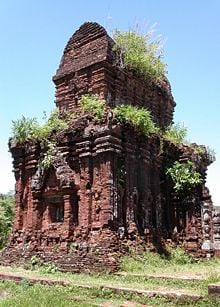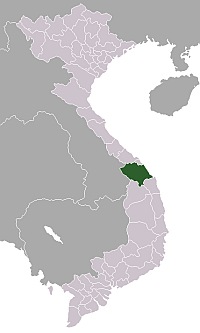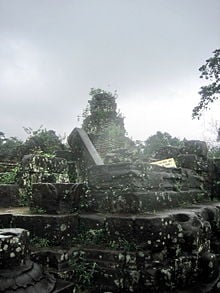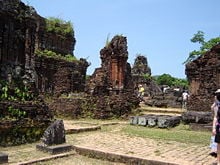Difference between revisions of "Mỹ Sơn" - New World Encyclopedia
Dan Davies (talk | contribs) |
Dan Davies (talk | contribs) |
||
| Line 36: | Line 36: | ||
== Archaeological studies == | == Archaeological studies == | ||
[[Image:My Son Ruins 1.JPG|thumb|220px|Ruins of My Son Sanctuary]] | [[Image:My Son Ruins 1.JPG|thumb|220px|Ruins of My Son Sanctuary]] | ||
| − | After the decline of the [[Chiêm Thành]] kingdom, the | + | After the decline of the [[Chiêm Thành]] kingdom, the following dynasties abandoned the Mỹ Sơn complex. 1885 the site had been rediscovered, after nearly 1000 years. In 1895 French researchers began extensive expeditions to the area, working in two phases: |
# 1898-1899: Louis Finot and Lunet de Lajonquière studied the inscriptions on the [[stele]]s. | # 1898-1899: Louis Finot and Lunet de Lajonquière studied the inscriptions on the [[stele]]s. | ||
# 1901-1902:Henri Parmentier studied the artistry, in 1904 he conducted and exhumation study there. | # 1901-1902:Henri Parmentier studied the artistry, in 1904 he conducted and exhumation study there. | ||
| − | In 1904, Finot and Parmentier announced | + | In 1904, Finot and Parmentier announced their discoveries at Mỹ Sơn. The research work of Parmentier revealed sixty eight architectural sites, divided into groups labeled from A, A' to N. |
| − | + | Art historian F.S. Tern divided the remains at Champa into seven phases based on the style of art and their phases of development. Mỹ Sơn has examples of all the styles, two of which theoretically originated there. The A1 temple has been often referred to as the architectural masterpiece of the Cham. The French archaeologists divided the architectural works at Mỹ Sơn into ten principal groups, A, A', B, C, D, E, F, G, H, K to enable a system of labeling sites by capital letter and number. | |
| − | |||
| − | The French archaeologists divided the architectural works at | ||
== Architecture == | == Architecture == | ||
Revision as of 22:21, 18 August 2008
| Mỹ Sơn Sanctuary* | |
|---|---|
| UNESCO World Heritage Site | |
| State Party | |
| Type | Cultural |
| Criteria | ii, iii |
| Reference | 949 |
| Region** | Asia-Pacific |
| Inscription history | |
| Inscription | 1999 (23rd Session) |
| * Name as inscribed on World Heritage List. ** Region as classified by UNESCO. | |
Mỹ Sơn (pronounced [mi sɤn]) designates a Hindu temple complex, located in the village of Duy Phú, in the administrative district of Duy Xuyên, Quảng Nam province, Central Vietnam, 69km southwest of Da Nang, and approximately ten km from the historic town of Trà Kiệu. Many Champa temples exist in a valley roughly two kilometers wide, surrounded by two mountain ranges. The site of religious ceremony of kings of the Champa dynasty,Mỹ Sơn also served as a burial place of Champa royals and national heroes. The Mỹ Sơn temple complex constitutes one of the foremost temple complexes of Hinduism in South East Asia and the foremost heritage site of this nature in Vietnam.
The temple complex often has been compared to other temple complexes in Southeast Asia, such as Borobodur (Indonesia), Angkor Wat (Cambodia), Pagan (Myanmar) and Ayutthaya (Thailand). My Son had been selected by UNESCO as a World Heritage Site in 1999, at its 23rd meeting, under the criteria C (II) as an example displaying the evolution and change in culture, and criteria C (III) as a foremost evidence of Asian civilization now extinct.
History
The construction of Mỹ Sơn began in the fourth century [1]. Over many centuries, craftsmen constructed the temple complex with buildings and stupas of varying sizes, becoming the main cultural center of the Champa civilization in Vietnam. In addition to religious celebrations, in which the dynastic rulers attempted to connect spiritually with the gods, Mỹ Sơn served as a cultural center and burial place for kings. The earliest relics date to the era of king Bhadravarman I (Phạm Hồ Đạt) who reigned from 381 C.E. until 413 C.E. He built a hall to worship Linga and Shiva. Mỹ Sơn shows the hallmarks of a strong architectural influence from India, present in the stupas of the temples. The inscriptions on the stele, written in Pali, also reveal the cultural influences from India.
The existence of an original wooden temple in the fourth century has been revealed based on other inscriptions on other steles. More than two centuries, during the seventh century, the temple burned down. King Sambhuvarman (Phạm Phạn Chi), who reigned from 577 C.E. until 629 C.E., used brick to rebuild the temple that still stands. It may have been moved from Khu Lật to Trà Kiệu at some point. Subsequently, kings continued to renovate temples and construct more temples to worship gods. Craftsmen used brick and other durable materials to build the structures, allowing for a view of that civilization to remain. The Cham construction techniques still baffle archaeologists, especially understanding how the craftsmen lifted the rocks into place and the material they used to hold the bricks together.
The stupas and tombs date from the seventh to the fourteenth century. The results of tomb exhumations revealed that Cham kings had been buried on the site since the fourth century. A total of over seventy buildings stand in the complex. The complex may have been the religious and cultural center of the Champa government while the government based in Trà Kiệu or Đồng Dương.
Archaeological studies
After the decline of the Chiêm Thành kingdom, the following dynasties abandoned the Mỹ Sơn complex. 1885 the site had been rediscovered, after nearly 1000 years. In 1895 French researchers began extensive expeditions to the area, working in two phases:
- 1898-1899: Louis Finot and Lunet de Lajonquière studied the inscriptions on the steles.
- 1901-1902:Henri Parmentier studied the artistry, in 1904 he conducted and exhumation study there.
In 1904, Finot and Parmentier announced their discoveries at Mỹ Sơn. The research work of Parmentier revealed sixty eight architectural sites, divided into groups labeled from A, A' to N.
Art historian F.S. Tern divided the remains at Champa into seven phases based on the style of art and their phases of development. Mỹ Sơn has examples of all the styles, two of which theoretically originated there. The A1 temple has been often referred to as the architectural masterpiece of the Cham. The French archaeologists divided the architectural works at Mỹ Sơn into ten principal groups, A, A', B, C, D, E, F, G, H, K to enable a system of labeling sites by capital letter and number.
Architecture
The architecture of the temples and tombs at My Son represent a convergence of a diverse range of styles, from the very historic to the newer variety. My Son E1 and F1 date to the eighth century, while My Son A2, C7 and F3 resemble the style of Hòa Lai at the turn of the nineth century. Mỹ Sơn A10, A11-13, B4, and B12 reflects the Đồng Dương style of the late ninth century. Mỹ Sơn B5, B6, B7, B9, C1, C2, C5, D1, D2, and D4 share the style of Mỹ Sơn A1 of the tenth century. And Mỹ Sơn E4, F2, and the K group of sites exhibits the transitional Mỹ Sơn A1-Bình Định style of the early eleventh century to the middle of the twelveth century. The final style of Bình Định (from the end of the 11th century to the start of the 14th) comprises Mỹ Sơn B1 and groups G and H.
Indian artistic and architectural style heavily influenced the temples. The complex consists of a major stupa (kalan) and many smaller stupas which encircle it. The stupas have a conical shape, representing the peak of Meru mountain, the residence of Hindu gods. The gates of the stupa face the East to accept the sun's rays. Many stupas exhibit ornate architecture and depictions of gods serenely surrounded by flowers. The majority of those depictions have decayed, only a few engravings remain with traces of gold that the Champa used. Most of the main temples at My Son revere Linga or Shiva, the protector of the Champa dynasty. Most devotees in past eras traversed the stupas in a clockwise direction.
Despite the large influence of Hinduism, representations of Buddhism also appear in My Son, as Mahayana Buddhism had become the foremost religion of the Champa in the 10th century. A few of the temples had been constructed in that period, and in the seventeenth century, some of the temples and stupas underwent reconstruction or expansion.
The craftsman at My Son developed their own indigenous styles. They discovered a way to "glue" bricks together using tree resin native to central Vietnam. The actual method has been lost. It appears that the Champa builders set the resin in place by baking whole monuments in a fire for a few days. Archaeologists believe that the monuments had been detailed many weeks later after the structures thoroughly cooled [2].
Stone Temple
At the My Son complex, one temple had been constructed of stone, the foremost stone temple in Champa civilization. The stele inscription reveals that the last stone alterations to that temple had been made in 1234. Today, the temple no longer stands, although it once stood at over thirty meters, the tallest building in the complex. Evidence gathered from the surrounding area show that it once had been part of the original temple in the fourth century.
Restoration
The restoration work began in 1937 with the work of French scientists. In the era 1937 to 1938, the A1 temple and smaller ones surrounding had been restored. In later years, from 1939 to 1943, B5, B4, C2, C3, D1, D2 had restoration completed. Many stupas and tombs (comprising group A and stupa A1, comprising the twenty four meter tall A1 and six surrounding stupas, previously in good condition), had been destroyed in 1969 in the Vietnam War. The surrounding area still suffers from the threat of unexploded land mines and other relics of war.
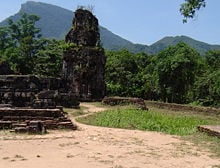
The majority of the temple sites in the center of the complex, such as the B, C and D groups survive, and although France removed many statues, prayer thrones to historical museums in Vietnam, such as in Ho Chi Minh City and the Cham Museum in Da Nang, a temporary museum has been set up in two of the temples with the funding of benefactors from Germany and Poland to display images of the remaining tombs and relics. On March 25 2005, Quang Nam Province held an opening ceremony, displaying the relics of My Son with an area of 5400 square meters and a display house of 1000 square meters accompanied by a one kilometer access road built with financing from Japan. Worries remain about the architectural construction of the temples, some vulnerable to collapse. From 2002 to 2004, the Ministry of Culture of Vietnam allotted around 440,000 USD to maintain the site. The Government of Italy funded a draft plan for UNESCO for the sum of USD 800,000, and the efforts of sponsors from Japan, to prevent further degradation. Those efforts also received funds from the World Monuments Fund.
See Also
Notes
- ↑ Mỹ Sơn Sanctuary - UNESCO World Heritage Center. Retrieved July 16, 2008.
- ↑ Myson map Index. Retrieved July 16, 2008.
ReferencesISBN links support NWE through referral fees
- Hammer, Richard. 1970. One morning in the war: the tragedy at Son My. London: Rupert Hart-Davis. OCLC 221327953.
- Tuan, Tran Huu. 2006. How much for world heritage?: the value of temple preservation in Vietnam. EEPSEA policy brief, no. 2006-PB6. Singapore: Economy and Environment Program for Southeast Asia. OCLC 136404112.
- Tuan, Tran Huu. 2006. Valuing the economic benefits of preserving cultural heritage: the My Son Sanctuary World Heritage Site in Vietnam. Singapore: Economy and Environment Program for Southeast Asia. ISBN 9781552502396.
External Links
- My Son photo gallery. Retrieved July 16, 2008.
- My Son. Retrieved July 16, 2008.
- UNESCO decree. Retrieved July 16, 2008.
| ||||||||||
Credits
New World Encyclopedia writers and editors rewrote and completed the Wikipedia article in accordance with New World Encyclopedia standards. This article abides by terms of the Creative Commons CC-by-sa 3.0 License (CC-by-sa), which may be used and disseminated with proper attribution. Credit is due under the terms of this license that can reference both the New World Encyclopedia contributors and the selfless volunteer contributors of the Wikimedia Foundation. To cite this article click here for a list of acceptable citing formats.The history of earlier contributions by wikipedians is accessible to researchers here:
The history of this article since it was imported to New World Encyclopedia:
Note: Some restrictions may apply to use of individual images which are separately licensed.
